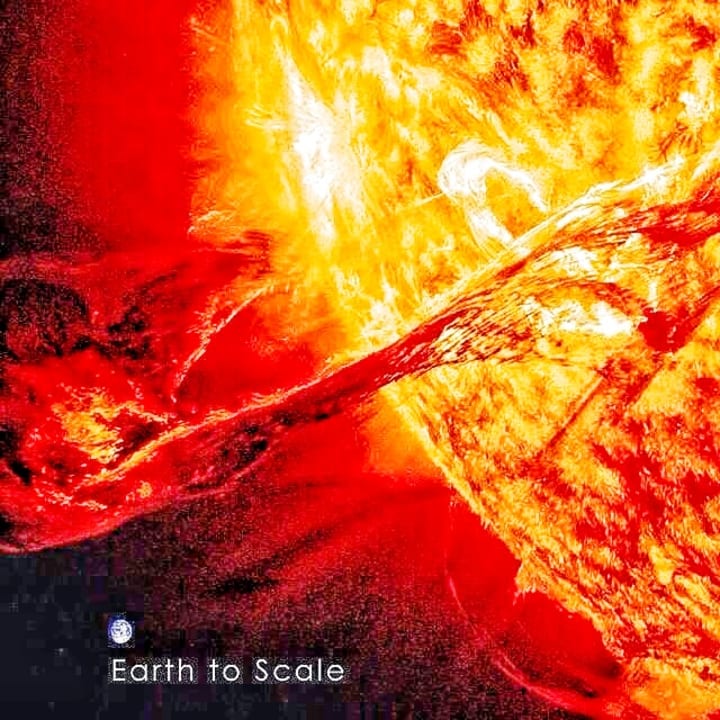Solar flares: What are they and how do they affect Earth?
lets see

what is solar flare?
Large explosions from the sun's surface known as solar flares produce powerful electromagnetic radiation bursts. What category a flare falls under depends on how powerful the explosion is. A-class flares are the smallest while M-, C-, and B-class flares are the most powerful.
According to the University Corporation for Atmospheric Research, these flares can be seen as intense flashes in a specific area of the sun and can last for many minutes (UCAR).
When magnetic energy accumulates in the solar atmosphere and is suddenly released, solar flares happen. The solar cycle, an approximately 11-year cycle of solar activity governed by the sun's magnetic field, is inextricably tied to these eruptions.
The surface of the sun has a chaotic magnetic field.
According to a NASA statement, magnetic fields are produced by electrically charged gases inside the sun that act as a magnetic dynamo to produce electrical currents (opens in new tab). According to NASA Space Place, the tumultuous nature of the gases that generate them causes these magnetic fields to twist, tangle, and reorganise themselves (opens in new tab). This irregular magnetic field behaviour, which is also referred to as solar activity, has the ability to cause solar flare eruptions from the surface, which discharge enormous amounts of electromagnetic radiation, which includes radio waves, microwaves, X-rays, gamma rays, and visible light.
Sunspots are darker, cooler areas of the solar surface where magnetic fields are extremely strong, and these areas are where solar flares typically come from. As a result, the quantity of sunspots can predict the possibility of an explosion of a solar flare.
According to the Space Weather Prediction Center of the National Oceanic and Atmospheric Administration(opens in new tab), the solar activity has an approximately 11-year cycle, with the sunspot maximum and sunspot hiatus occurring at the same times (NOAA). It is improbable that a solar flare will occur when there are no sunspots and the sun is in a low-activity state.

SOLAR FLARES TODAY
Solar activity is on the rise as we experience solar cycle 25. Solar maximum is predicted to occur in 2025. To find out if there is a solar flare today and to keep up with the latest space weather findings, SpaceWeatherLive.com (opens in new tab)records the most recent 24 hours of solar X-ray data from the primary GOES-16 satellite and displays such activity in useful graphs along with the percentage chance of different types of solar flares.
TYPES OF SOLAR FLARES
There are five classes of solar flares, according to NOAA(opens in new tab). Their designation depends on the intensity of X-rays emitted. Each class letter represents a 10-fold increase in energy output, similar to the Richter scale that measures the strength of earthquakes.
According to NASA(opens in new tab), X-class flares are the most powerful solar flares. Then there are M-class flares that are 10 times smaller than X-class flares, then C-class, B-class and finally A-class flares which are too weak to significantly affect Earth.
A narrower scale from 1 to 9 offers the flare rating for each letter class more accuracy, with higher numbers denoting stronger flares within the class.
There is no class more powerful than X-class, hence X-class flares can defy this nine-point rating norm with higher ratings. NASA claims that a solar flare in 2003 was so strong that it overwhelmed the sensors used to measure it. Before they stopped working, the sensors detected an X28 flare.
Fortunately, X-class flares happen around 10 times a year on average, and flares so intense are even less often than the one observed in 2003.

HOW DO SOLAR FLARES AFFECT EARTH?
Different types of flares, particularly X-class flares, affect Earth, satellites and even astronauts.
Fortunately for us, A and B-class solar flares are the most frequent and weakest of the solar flare classes, unable to significantly damage Earth. According to SpaceWeatherLive.com, C-flares are similarly rather mild, having little to no impact on Earth(opens in new tab).
Things start to become a little more interesting with the two major kinds of flares.
Coronal mass ejections, which are significant releases of solar plasma and magnetic field, can be caused by powerful M-class and X-class flares. Geomagnetic storms may result from this activity, which might disturb the magnetosphere of the Earth. Such geomagnetic storms may cause auroras to appear closer to the equator than is normally possible.
In 1989, a large solar flare accompanied a coronal mass ejection and hit Earth, plunging the entire province of Quebec, Canada, into an electrical blackout that lasted 12 hours, according to a NASA statement(opens in new tab). The solar eruption triggered a geomagnetic storm on Earth, resulting in aurora borealis, or northern lights, that could be seen as far south as Florida and Cuba.
Solar radiation storms can also emit fast-moving charged particles, which carry a lot of energy and can endanger astronauts and Earth-orbiting spacecraft. During these storms, astronauts on the International Space Station need to seek shelter and all extravehicular activities are paused. Radiation-sensitive systems on satellites are powered down until the radiation storm has passed.
During an eruption, M-class and X-class flares can also cause minor to extensive radio blackouts on the side of Earth facing the sun. Radio blackouts mostly affect High Frequency (HF) (3-30 MHz) radio communications though sometimes Very High Frequency (VHF) (30-300 MHz) and higher frequencies can be affected, according to SpaceWeatherLive.
The lower ionosphere of the Earth's atmosphere, through which radio waves travel, has higher electron densities, which is what causes the radio blackouts. Radio waves are unable to penetrate higher layers that would refract the radio signals back down to Earth because of the increased electron density, which causes them to lose more energy as they move through the layer.
With almost 2,000 minor incidents of this kind occurring each solar cycle, radio blackouts are the most frequent space weather phenomenon to have an impact on Earth.
According to the NOAA Solar Radiation Storm Scale, radio blackouts can range in severity from R1 to R5, depending on the power of the solar flare. The South African National Space Agency defines one as a small incident and five as an intense event (opens in new tab). Radio blackouts caused by R5 events can endure for many hours and cover the entire sunlit side of the planet. Fortunately for us, less than one R5 occurs on average during each solar cycle.
About the Creator
ASHIF Navheed
i am just like others who need answers for the questions that raise in their head
Enjoyed the story? Support the Creator.
Subscribe for free to receive all their stories in your feed. You could also pledge your support or give them a one-off tip, letting them know you appreciate their work.






Comments
There are no comments for this story
Be the first to respond and start the conversation.